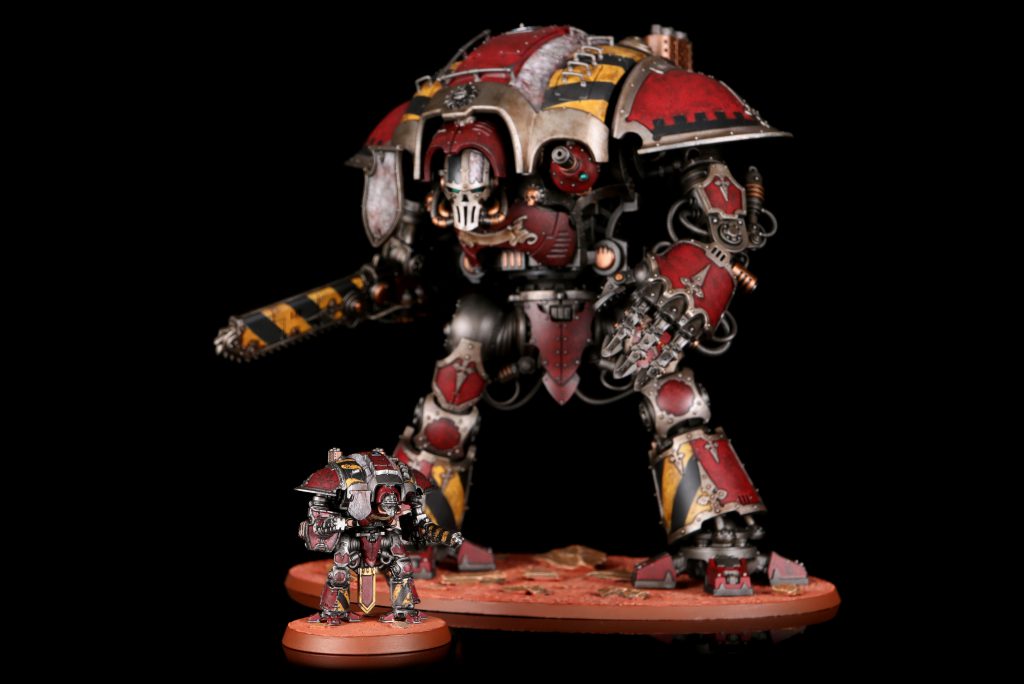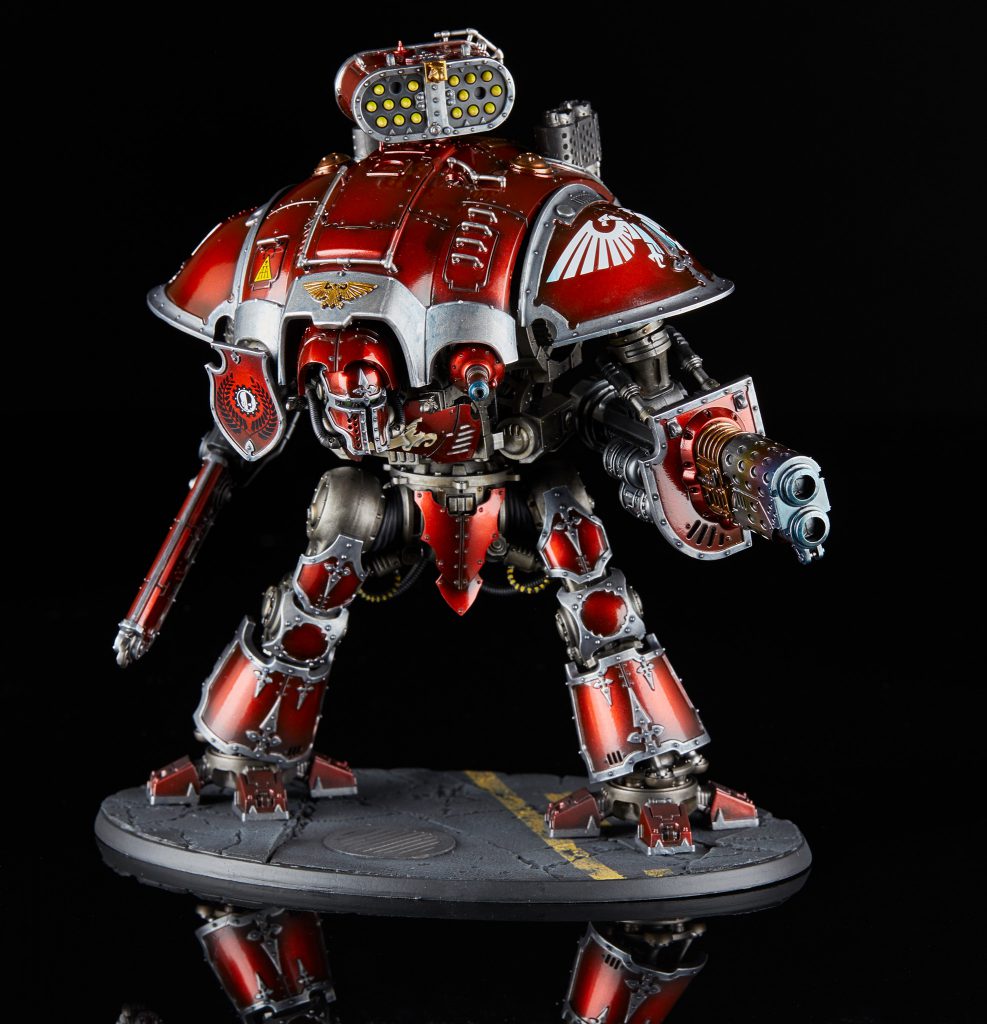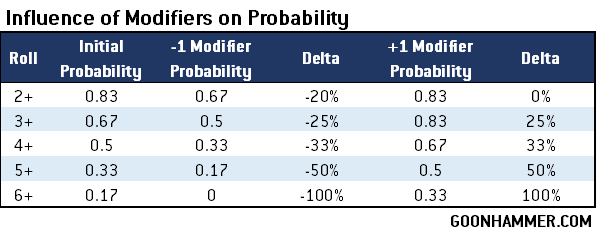This week’s Hammer of Math takes a look at the effects of the various House Martial Traditions available within Codex: Imperial Knights.
One of the advantages of writing a weekly column on gaming statistics is that I can exploit this venue to explore things that I’m personally interested in. So, for example, if I signed up for my first 40k tournament in 10 years and preparing for said tournament means I have to take a unit of Freeblade Armigers in order to field an actual 2000 point army, then I might want to find out which Martial Tradition makes the most sense. And since I did sign up for my first 40k tournament in 10 years, and since said tournament is two weeks away, I’m going to write a column about it. My original plan was to put together every Martial Tradition into a single article, but there is a lot to cover so instead I’ll start with the House Martial Traditions and then finish up with the custom options next week.

Martial Traditions
Martial Traditions are the Knightly equivalent of faction bonuses. When you create an Imperial Knights army, the first thing you need to do is decide if your allegiance is to the Cult Mechanicus or the Imperial Administratum. In the case of a pre-written house like House Terryn this allegiance is already established. But for those who wish to go their own way (or those who are Freeblades), the allegiance determines which set of Martial Traditions you can access. The allegiance also gives non-Freeblade units a bonus in the form of either the Sacristan Pledge or the Vow of Honour. Freeblades who form a Freeblade Lance Army of Renown gain the Indomitable Heroes ability, but a unit of Freeblades using the Wandering Hero Detachment rule to join another army gain nothing.
Players from a custom house choose one Martial Tradition from whichever list corresponds to their allegiance. Freeblade units also can select from the Martial Tradition of a particular allegiance, but also gain access to Freeblade Martial Traditions. One limitation is that Freeblades cannot use Martial Traditions which connect them to an established house (Glorified History and Fealty to the Cog). They’re on their own.
Many of the Martial Traditions provide a modifier or a re-roll. The chart below provides some guidance on how probability changes based on the extent of the modifier. For example, a +1 modifier on a 3+ to hit improves the probability of hitting by 25%. In the case of re-rolls the improvement is a function of the probability that the re-roll will occur. For example re-rolling 1s provides a flat 17% improvement, while re-rolling all misses on a 4+ to hit is a 50% improvement.

Questor Allegiance Oaths
Everyone but Freeblades have swore a Questor Allegiance Oath, which provides two effects. Houses under Questor Mechanicus have sworn the Sacristan Pledge, which increases the Wounds characteristic by 1 (or 2 if the model is Titanic), and allow the unit to regain 1 lost wound per round. For the Armigers and Questoris-class Knights this is an 8% increase in how much damage they can, not including the effect of repairs. Questor Imperialis units gain the Vow of Honour, which adds 1 to Advance and charge rolls, allows the model to ignore any modifiers to Advance and charge rolls, and allows the unit to move an additional 1″ when making pile-in or consolidate moves. The Indomitable Heroes tradition available to the Freeblade Lance Army of Renown is a hybrid, combining the ability to regain a wound from Sacristan Pledge with the ability to ignore modifiers to Advance and charge rolls of the Vow of Honour.
Household Traditions
Household Traditions require you to either be a member of a particular noble house or to use Glorified History or Fealty to the Cog.
House Terryn (Imperialis): Gallant Warriors
House Terryn units can roll an additional D6 and discard one of the dice results whenever they make an Advance or charge roll. Generally in this situation you want to discard the lowest, which provides a significant increase the probability distribution. The chart below shows the numbers; for Advance rolls the average minimum result goes from 4 to 5, while for charge rolls the average minimum goe from 7 to 9. Note that this does not include the bonus movement from Vow of Honour.
House Griffith (Imperialis): Glory of the Charge
House Griffith adds 1 to the Attacks characteristic of a model every time it charged, was charged, or performed a Heroic Intervention. Most Knights have an Attacks characteristic of 4 which means on the charge House Griffith units are 25% more lethal in melee. The exception is the Gallant and Cerastus Lancer (5 attacks base so 20% more lethal with this ability), and the Acastus units which have 3 attacks base so are 33% more lethal.
House Cadmus (Imperialis): Hunters of the Foe
House Cadmus fighters get to re-roll wound rolls in melee attacks. If the target is a VEHICLE or MONSTER then you re-roll 1s (17% increase), while if the target contains 6 or more models the wound roll is re-rolled. The types of threats that come in units of 6 or more are generally of a lower toughness so the bonus in that case is likely 33% or less. Or you’re facing Leagues of Votann and the ability has no effect, because army-wide bonuses which nullify other army-wide abilities will definitely not leave anyone feeling unhappy.
House Hawkshroud (Imperialis): Oathkeepers
House Hawkshroud are obnoxiously hard to degrade thank to two bonuses. The first bonus is that they double the amount of wounds required to drop them down on the wound chart. For something like a Questoris-class Knight this means the model won’t see any degradation in performance until they have 6 wounds remaining. The second is that the models always count as having one more Honour point than the army itself. This mean that House Hawkshroud units will never achieve Dishonoured status.
House Mortan (Imperialis): Close-Quarters Killers
House Mortran units get to re-roll hit rolls of 1 in melee, leading to a 17% increase in lethality. This makes Mortran’s bonus worse than House Cadmus (since they also re-roll 1s and also get a bonus against larger units) as well as House Griffith unless the unit is stuck melee and doesn’t get charged.
House Raven (Mechanicus): Relentless Advance
House Raven units ignore modifiers to Move characteristics and Advance rolls, and they always count as having Remained Stationary. There are a significant number of variables which make it difficult to quantify the effect of this tradition, but at the very least being able to Advance and fire Heavy weapons is a pretty significant boost in mobility.
House Taranis (Mechanicus): Omnissiah’s Grace
House Taranis units can ignore non-mortal wounds on a D6 roll of 6. We’ve covered effective wounds multiple times, and the key element of that is that abilities which ignore damage (mostly Saves and abilities likes Omnissiah’s Grace) have a major impact because they also apply to future attacks in addition to those they save. The limitation on mortal wounds is interesting, but against most threats ignoring wounds on a 6+ means that the Knight effectively has 20% more wounds. That’s particularly significant on units which have Wounds characteristics of 26 or 30 when you take into account that these units also receive the additional wounds from Sacristan Pledge.
House Krast (Mechanicus): Cold Fury
House Krast get a core mechanic for melee attacks similar to the Leagues of Votann Eye of the Ancestors, automatically wounding on an unmodified hit roll of 6 (or 5 if the target is TITANIC). You can check out the change in wounding probability on the linked article, but in general if the hit roll is 3+ the bonus probability against non-TITANIC targets ranges from 5% to 125% depending on the wound roll. Against TITANIC targets you’re generally wounding on a 3+ to 5+ which translates to a bonus of 25% for a 3+, 50% for a 4+, and 100% for a 5+. If you get in melee combat this bonus can do a lot.
House Vulker (Mechanicus): Firestorm Protocols
House Vulker can re-roll hit rolls of 1 on ranged attacks against the closest target. This means that if your target is properly screened the bonus is irrelevant, but with proper positioning it’s a 17% improvement in lethality.

Wrapping Up
For the most part Martial Traditions are geared towards melee, bringing about the notion of Knights charging into the foe. Only in this case the Knights are multi-story walking monstrosities that can crush hordes of enemies by simply jumping up and down like an angry toddler. Of the 4 Martial Traditions geared towards melee, the attack bonus from House Griffith is the most effective due to the bonus on driving rolls versus gatekeeping rolls. The four remaining Houses provided bonuses which are more universal. House Hawkshroud are resilient and more flexible in terms of Honour, House Raven is extremely mobile while still firing their weapons, House Taranis are significantly harder to kill, and House Vulker is the only one with a dedicated ranged bonus.
Of course there is more to an army than just the martial traditions, and faction bonuses like Relics, Stratagems, and Warlord traits should all be considered when examining which House is right for you. Personally I really the bonuses of House Raven and House Taranis, as they’re useful in a wide variety of situations and can be remarkably effective.
Next week we’ll follow up with the Martial Traditions available to custom houses and Freelancers.
Thanks for reading! If you have any questions or comments feel free to drop us a note in the Comments below or email us at contact@goonhammer.com. That’s also the best way to suggest topics for future articles.




